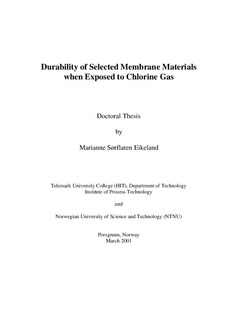| dc.contributor.author | Eikeland, Marianne Sørflaten | |
| dc.date.accessioned | 2007-03-06T10:51:46Z | |
| dc.date.accessioned | 2017-04-19T12:52:41Z | |
| dc.date.available | 2007-03-06T10:51:46Z | |
| dc.date.available | 2017-04-19T12:52:41Z | |
| dc.date.issued | 2001 | |
| dc.identifier.isbn | 82-7984-197-0 | |
| dc.identifier.issn | 0802-3271 | |
| dc.identifier.issn | 0802-3271 | |
| dc.identifier.uri | http://hdl.handle.net/11250/2438577 | |
| dc.description | Avhandling (dr.ing.) - Høgskolen i Telemark / Norges teknisk-naturvitenskapelige universitet | |
| dc.description.abstract | This thesis is focusing on the durability of selected membrane materials when exposed to chlorine gas in the temperature range 30-100°C. Studies of the changes of membrane separation properties and the mechanisms promoting these changes have been studied. The selected membrane materials were poly(dimethylsiloxane) (PDMS), Fluorel®1, fluorosilicone, and blends of PDMS and Fluorel. The thesis is organised in seven chapters. The first chapter gives an introduction to the background of the work. The second chapter presents the theory for gas separation using dense rubbery membranes. The properties of the selected membrane materials are presented in chapter three. The fourth chapter describes degradation mechanisms for polymeric materials in general and for the selected membrane materials in particular. Presentation of the experimental work is given in chapter five, while the results with discussions are presented in chapter six. The conclusions and recommendations for further studies are given in chapter seven. Five appendixes are attached: Appendix A describes the calculations of permeability and solubility coefficients and the accuracy of the experimental measurements. Appendix B summarises the measured values in tables and Appendix C describes the analytical methods. Appendix D gives the properties of the gases used in the experiments. Appendix E is the article "Durability of Poly(dimethylsiloxane) when Exposed to Chlorine Gas", submitted to the Journal of Applied Polymer Science. Highly crosslinked PDMS was found to have an initial high permeability for chlorine gas and a high Cl2/O2 selectivity. However when exposed to chlorine gas the permeability decreased significantly. Crosslinking of the PDMS polymer chain and chlorination of the polymer gave a denser polymer structure and thus lower permeability. Fluorel showed very low permeabilities and selectivities for the gases in question and was thus not interesting for this membrane separation. It was however found that permeability decreased upon exposure to chlorine gas followed by an increased selectivity for Cl2/O2 in this material. This may be a result of chlorination or crosslinking. Also the degree of crystallinity will influence the transport through the membrane. The FT-IR analysis showed no significant changes in the structure of Fluorel. Different blends of poly(dimethylsiloxane) and Fluorel were tested. These materials had initially high permeabilities and high selectivities. The permeability however decreased significantly upon exposure to Cl2 and the membrane was ruined after few days. Chlorination of the methyl group in PDMS, (C-Cl bond), and formation of cyclic compounds or crosslinking were observed also in the blends. Fluorosilicone showed initially high permeabilities and good selectivities but degraded quickly upon exposure to chlorine gas. This fact ruled out this material. | |
| dc.format.extent | 1916817 bytes | |
| dc.format.mimetype | application/pdf | |
| dc.language.iso | eng | |
| dc.publisher | Telemark University College | |
| dc.subject | Membrane materials | |
| dc.subject | Chlorine gas | |
| dc.title | Durability of selected membrane materials when exposed to chlorine gas | |
| dc.type | Doctoral thesis | |
| dc.type | Peer reviewed | |
| dc.rights.holder | © Copyright The Author. All rights reserved | |
| dc.subject.nsi | 562 | no |

